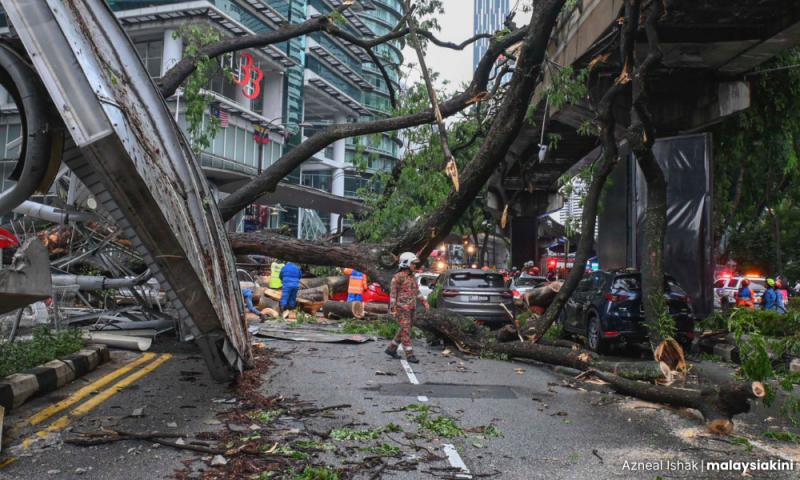LETTER | Consequences of planting and cutting trees
LETTER | A little more than half a century ago in 1973, I worked as a full-time tourist guide and my office was at the Merlin Hotel at Jalan Treacher in Kuala Lumpur. They were later renamed Concorde Hotel Kuala Lumpur and Jalan Sultan Ismail.
Then, I regularly patronised the nearby mamak stall shaded by a big raintree. It was the same tree that recently toppled and caused mayhem, damaging 17 cars, inflicting injuries with one fatality, blocking traffic on both sides and the monorail track above.
I can vouch that the tree was very much older than 50 years as mentioned by the Minister in the Prime Minister’s Department (Federal Territories) Dr Zaliha Mustafa who visited the site last Tuesday. Many raintrees in the country were planted more than a hundred years ago,
Fifty years ago, all tourist guides also drove tour cars licensed as limousine taxis to handle free independent travellers (FITs). One day, I drove two American ladies from Kuala Lumpur to Penang using the old trunk road and overtaking other vehicles can be dicey.
After driving past the majestic rain trees with branches arching from one side of the road to the other side and almost dipping into the water at the Taiping Lake Gardens, we had tea at the old rest house and enjoyed a panoramic view of Maxwell Hill, later renamed Bukit Larut.
One of the ladies remarked that it was the most beautiful sight she had ever seen. Mind you, she was very well-travelled and her experiences were not limited to travelling in a group. Even to this day, few FITs have watched an unobstructed view of a jungle-clad mountain in Malaysia.
This is only possible if it is similar to a volcano, rising on its own above relatively flat ground. Between the rest house and Bukit Larut, there were no hills, mountains or manmade structures to block or spoil the breathtaking and serene view.
But I was rather unimpressed as jungles were found almost everywhere in Malaysia at that time. However, in later years, I was deeply saddened by the wanton logging of our virgin jungles and replanting much of them with oil palms.
Together with the gradual dumbing down of our education from 1970, these are the greatest irreplaceable losses suffered by our country. They could only be matched in scale by endemic corruption, mostly by selfish political leaders and civil servants with no integrity or shame.
Recently, MACC chief commissioner Azam Baki said Malaysia lost around RM277 billion to corruption over the past five years.
Incidentally, Bukit Larut is not a hill but a mountain, as it is 1,250m high. Hills (Bukit) above a thousand feet are called mountains. The Warisan Merdeka Tower in Kuala Lumpur at 678.9m is taller than low mountains.
When I brought tourists to the National Park, one of the hiking trails passed by a tall Tualang tree with huge buttress roots to support its weight, as they can grow up to 88 metres.
In cities, towns and parks, rain trees spread their roots sideways underground and some are seen when they surface above ground if not cut off or covered by concrete or road.
My La Salle Klang classmate Danny Tio, still a regular and fit hiker in his seventies, commented, "Why that big tree in KL fell - not because it is old but because the roots were cut completely all round to build the walkway. The tree was just standing like a pencil."
While driving a premier taxi in 2000, I picked up a Caucasian passenger. Upon learning that he works as a landscape architect, I drove him to Subang Jaya and showed him the artificial palm trees erected by the roadside. He took many photos for his next article in a landscape magazine.
His trip was certainly made more fruitful. Who would have thought, except in Malaysia, to decorate roads with artificial palm trees when natural ones could be planted and thrive in our climate? To landscape architects, such manmade structures must be hideous.
He was also impressed with my knowledge of trees planted by the roadside. I told him most were grown from rooted cuttings, would not have a tap root, and could easily topple. For example, a mango tree planted from seed grows tall and firm with a tap root anchored deep in the ground.
Therefore, planting trees by the roadside must be carefully thought out, as they could kill while remaining upright if speeding vehicles were to crash into them. Old trees need not be removed totally. If their roots are healthy, new branches and leaves could sprout from the stumps.
The views expressed here are those of the author/contributor and do not necessarily represent the views of Malaysiakini.
Please join the Malaysiakini WhatsApp Channel to get the latest news and views that matter.
RM12.50 / month
- Unlimited access to award-winning journalism
- Comment and share your opinions on all our articles
- Gift interesting stories to your friends
- Tax deductable
